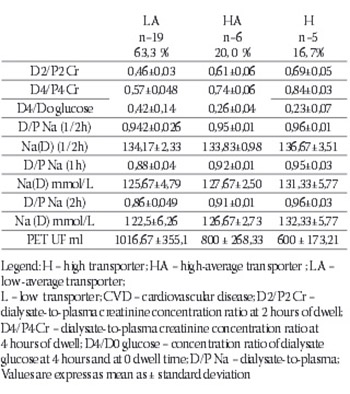The Importance of Using Peritoneal Equlibration Test for the Peritoneal Transport Type Characterization in Continuous Ambulatory Peritoneal Dialysis Patients
DOI:
https://doi.org/10.17305/bjbms.2010.2645Keywords:
peritoneal membrane function, peritoneal equilibration test, ultrafiltration failureAbstract
The aim of this study was to analyze the importance of the peritoneal equilibration test (PET) in evaluation of the peritoneal membrane tranport status in patients treated with continuous ambulatory peritoneal dialysis (CAPD). The study included 30 adult continuous ambulatory peritoneal dialysis (CAPD) patients, 16 male and 14 female, mean age 61 ± 16,5 years with a prescription of four exchanges of 2 litres (L) per day, who underwent peritoneal equilibration test (PET). Eleven of patients were diabetics. A modified PET was performed during a 4 hours dwell using 4,25% glucose dialysis solution. The dialysate/plasma ratio of creatinine (D/P) at the end of the procedure, and the dialysate 240 min/initial dialysate ratio of glucose (D/D0) were calculated and used as parametar of solute transport. With the test, chategorisation of patients was possible into high (H), high-average (HA), low average (LA), and low (L) transporters. In multivariate analysis age, gender, time on dialysis, comorbid diseases, diabetes mellitus (DM), serum albumin, were concidered as independent factors influencing the PET. Among 30 patients 5 (16,7%) were classified as H transpoters, 6 (20%) as HA, and 19 (63,3%) as LA. There were no patients in low category. Creatinine D/P at 4 hours was not different DM and non-DM patients. There were significant differences in gender, comorbid disease, serum albumin, D4/D0 glucose and volume drained in 4 hours. The high transporter group had higher proporsion of man (p<0,05), higher proportion of patients with comorbid diseases, lower serum albumin concentration (p<0,001), lower D4/D0 glucose (p<0,001), and lower drained volume (p<0,001). The PET was en easy, inexpensive, reliable test to assess peritoneal transport type and it also provided information about peritoneal clearance of solutes and ultrafiltration. Peritoneal transport type classification was recognized not only as aid for prescription, but also as a prognostic index.
Citations
Downloads

Published
Issue
Section
Categories
How to Cite
Accepted 2017-11-10
Published 2010-04-20









